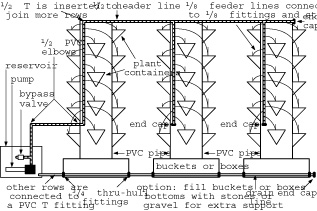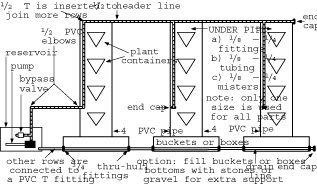This system is a typical vertical garden you can build on the cheap, if you have the time.
Build a Vertical Garden
Option D: Column System #1
Top-feeding / Aeroponic System Using Pipe with Containers
Tools
1. Drill and 1-inch hole saw.
2. Exacto knife.
3. Crescent wrench.
4.A custom-sized hole saw (i.e. 3 1/2-inch) for plant containers, if necessary.
5. Saw.
Materials
1. One mesh pot per plant (i.e. 2 inches), if necessary.
2. One 1/8 to 1/4-inch fitting per plant.
3. One piece of 1/8-inch tubing per plant that is connected from header line to container.
4. One reservoir.
5. Six-inch pipe that is cut to equal lengths and that are used to hold the plants.
6. Pump.
7. Bypass valve.
8. 1/2-inch black poly tubing for header lines.
9. 1/2-inch black poly elbows.
10. 1/2-inch black poly Ts.
11. 11/2-inch black poly end caps.
12. 3/4-inch flex hose.
13.One bucket per pipe.
14. 3/4-inch thru-hull fittings.
15. 3/4-inch end cap.
16. 6ml black poly.
17. Twine.
18. Stones / gravel.
Plant-Holding Components
A. Choosing the desired pipe is the first step. Bigger pipe means there is more area for vegetation to cover. There are two options.
1. 4 to 8-inch PVC(or better yet, HDPE 2 plastic) is a good pipe to use. Custom-sized holes should be cut into the pipe at the desired spacing (i.e. 8 to 12-inch centers). The hole sizes must match the size for the plant holders. The holders are special parts that may need to be tracked down. Some holders make space for a mesh pot while some holders are like a built-in mesh pot.
(A column systems that does not use plant containers is described a little further on in this book.)
2. This easiest option is to buy the pipe with the plant holders built into the plastic. They come with holders on one side for indoor systems, or holders on four sides for outdoor systems.
B. All piping (i.e. 4 to 8-inch PVC) should be cut to the desired height. For easy maintenance, the height should be less than the length of an outstretched arm so that a ladder is not needed while building the system.
Option: Pipe can be filled with medium.
C. All lengths of large pipe should have end caps (or 6ml plastic) attached to the top of the pipe in order to keep out the light.

Drain Components
D. The buckets (or boxes) at the base of the piping should have holes made about 2 inches from the bottom on each side using a 1-inch hole saw for 3/4-inch thru-hull fittings that will be inserted into each hole. Square plastic boxes, plastic buckets, or plywood boxes with two layers of black poly can be used. If plywood is used, care must be used when the thru-hull fittings are inserted because any rips will trap water under the plastic, which can lead to an overflow.
E. The pipes should be placed in the boxes with a snug fit. A hole saw or jigsaw is used to make the holes. Stones or gravel can be placed in the bucket or box in order to give extra support.
F. The reservoir should have a hole about 2 inches from the bottom that is made with a 1-inch hole saw. The hole should have a 3/4-inch thru-hull fitting inserted into it. The end of the 3/4-inch thru-hull fitting will be attached to the T-fitting from the drain line of the first bucket (or box).
G. The pipes should be placed in the desired locations.
H. Each row will have a T-fitting inserted at the end of the drain line that is nearest the reservoir. If 3/4-inch flex hose is used, a 3/4-inch PVC T will be used. If 1/2-inch poly hose is used, a 1/2-inch PVC T will be used to connect the rows together. 1/2-inch black poly is the cheapest option, but 3/4-inch flex hose is the superior product. The last row will be have a 5-inch piece of tubing connected to the loose end of the PVC T, followed by an end cap. Using a PVC T is a good idea if more rows may be connected later.
Feeder Line Components
I. 1. A long piece of 1/2-inch poly tubing should be run along the tops of the pipes until it reaches the last one in the row. Twine and screw-in hooks can be used to keep it on top.
2. The front of the 1/2-inch poly tubing should have a 1/2-inch PVC elbow or PVC T inserted into it. A PVC T is used instead of the PVC elbow if more than one row is used.
3. The main line is then cut and a 1/2-inch PVC T is installed for each length of vertical pipe.
4. The PVC T is connected to pieces of 1/2-inch poly tubing that run down the sides of the large piping to a height just above the top of the reservoir.
5. The poly tubing is then connected to 1/2-inch PVC end caps.
6. The appropriate connection fittings that connect to the individual feeder lines should be inserted into the 1/2-inch header lines that run along the standing pipes. One fitting is used for each plant.
7. Lines are cut to a length that reaches each plant container with a little slack, and inserted into the connection fittings.
8. Lines are connected to alligator stakes.
J. The pump is connected to a piece of poly tubing that reaches the outside of the reservoir.
Option: A bypass valve can be inserted between the pump and the first 1/2-inch PVC elbow. To insert a bypass valve, a 1-inch chunk of the 1/2-inch poly line is cut out, a 1/2-inch PVC T is inserted, a 5-inch chunk of 1/2-inch poly plastic is connected, and a lightweight plastic tap is attached to the 5-inch chunk of black poly.
K. The end of the line is connected to a 1/2-inch PVC elbow.
L. The 1/2-inch PVC elbow is connected to a piece of 1/2-inch poly tubing that reaches the tubing that hangs down from the front of the first pipe.
M. A 1/2-inch PVC elbow is used to connect these last two loose ends.
Feeding
It is easiest to feed the plants with the pump timer running full-time only during the light hours. A solar pump runs during light hours. But plants can be fed continuously (all day and all night). Also, plants can be fed intermittently (i.e. every 20 minutes for 2 minutes, or every 2 to 5 minutes for 15 to 30 seconds).

Aeroponic Conversion
Making the aeroponic version of this system is easier than making the top-feeding system.
A. The lines that run down the outsides of the column will now run inside. The appropriate misters should be inserted into the ends of the smallest tubing (i.e. 1/8-inch).
B. The pump should be changed to a high-pressure pump designed for aeroponics. The pump should be the size required for the garden dimensions.


